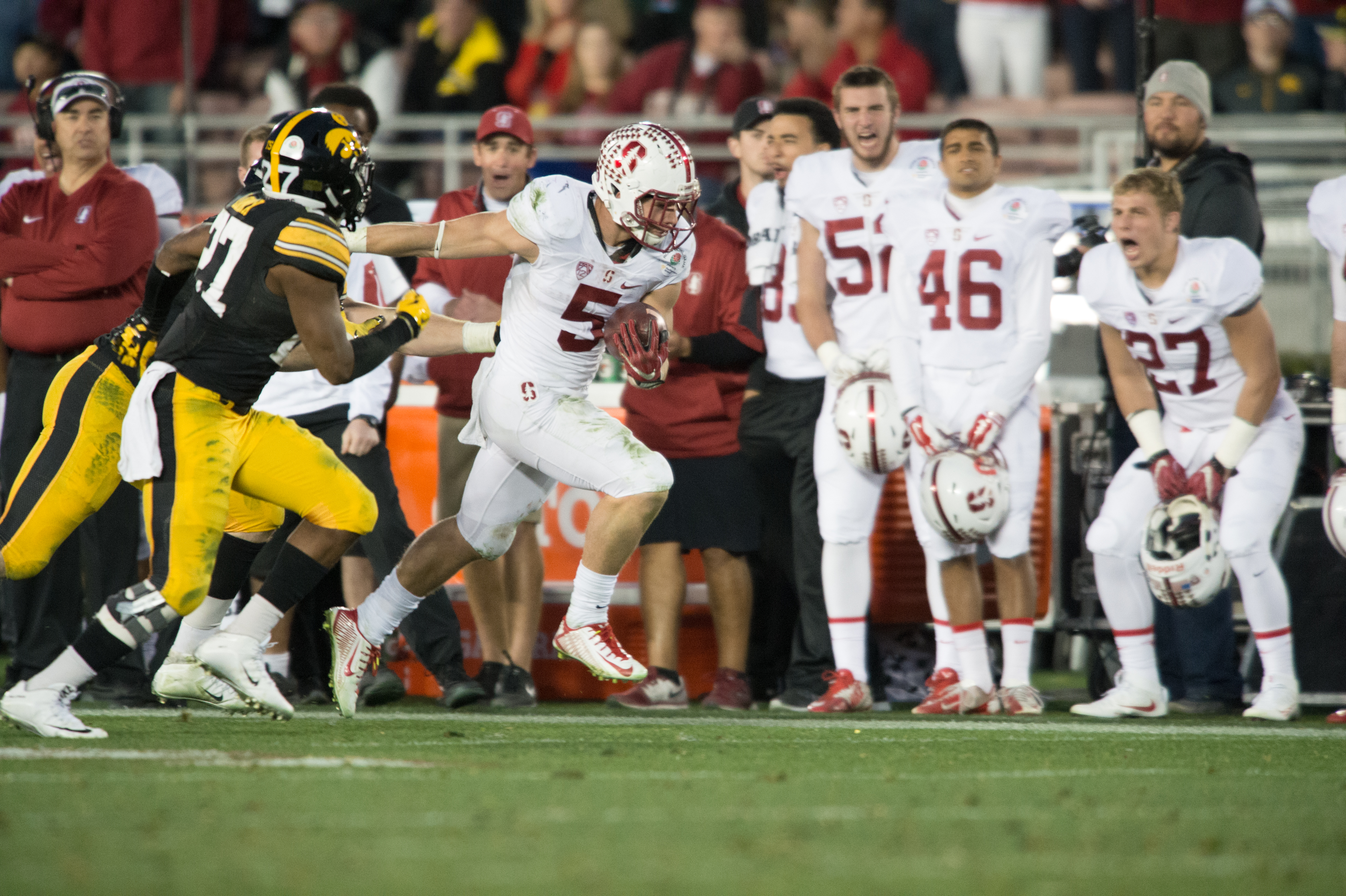As part of The Daily’s preview coverage of Stanford football’s fast-approaching 2016 campaign, football analysts Vihan Lakshman, Do-Hyoung Park and Michael Peterson sat down to answer questions for the first part of our preview roundtable series, which will focus on the team’s offense.
This is the second of a 12-part preview of the 2016 football season. Part 1, which focused on the running backs and fullbacks, can be read here.
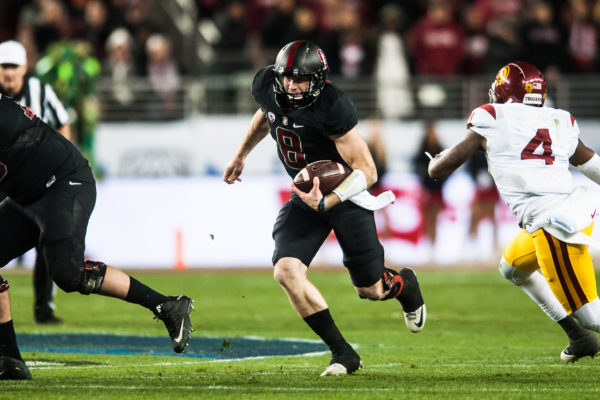
Stanford loses a whopping six starters from a 2015 offense that ranked as one of the best in school history and scored 30 points or more in each of its last 13 games. Which player will Stanford miss the most in 2016?
Vihan Lakshman (VL): There are a lot of very good answers to this question, and that speaks to just how special the pieces of the 2015 offense were in revving up the engine to levels not seen since the days of Andrew Luck. With no real incorrect response, I’m going to give the Tunnel Workers Union some love and go with left guard Josh Garnett. The reigning Outland Trophy winner, awarded to the best interior linemen in the nation, was one of the best run blockers in the nation, and Garnett’s ability to open up gaping holes in the running game made Christian McCaffrey even more dangerous. The current San Francisco 49er was also an adept pass protector, and, as a team captain, a very vocal leader in the locker room. The loss of Garnett’s tangible production as the best guard in college football as well as his intangible contributions in pushing that 2015 team to achieve its championship potential will absolutely be missed.
Do-Hyoung Park (DHP): I don’t think I can really go wrong by picking Stanford’s all-time winningest quarterback and the only quarterback in conference history to start three Rose Bowls, so that’s exactly what I’m going to do. Even putting aside the fact that he won 36 games in three-plus years under center and never finished outside the nation’s top 30 in pass efficiency, Kevin Hogan meant so much more to this team for his evolution from a wide-eyed freshman to another coach on the field by the time his Stanford career wrapped up and his poise and leadership that led to him becoming one of very few two-time captains in Stanford’s recent history. His playbook knowledge was unparalleled, and we’ll probably never know the extent of just how many calls he made in that huddle or how deftly he could adapt the absurdly complicated Stanford offense to meet any changing situation on the field. His complete command of Stanford’s offensive system will be the single biggest blow.
Michael Peterson (MP): Another name not previously mentioned that would be worthy of this honor is All-Pac-12 first team tight end Austin Hooper, who had a phenomenal 2015 season, but I’m going to agree with Do on this one. At times Kevin Hogan almost single-handedly propelled the 2015 Stanford offense with his arm (Notre Dame) and his feet (Washington State), but arguably his most important contribution to the team was his calm leadership, his gutty performances and his heart. He was a two-time captain, an unquestioned leader and a brilliant decision-maker who knew the playbook inside and out. Lost in Christian McCaffrey’s prolific season was also the fact that Hogan set the school record for passing efficiency in a single season. There’s no doubt he will be missed as both as a leader and as a playmaker.
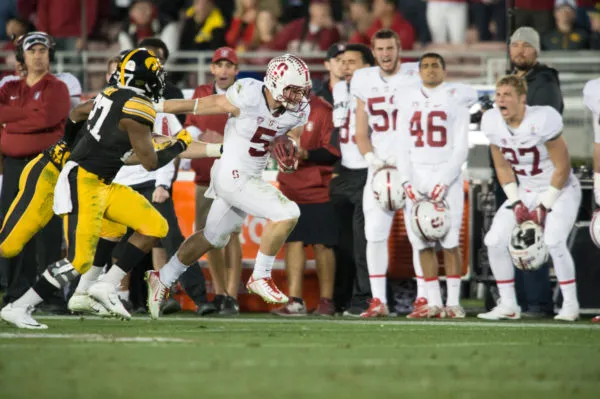
After a national-record-breaking 3,864 all-purpose yards, school-recording-breaking 2,019 rushing yards and an AP Player of the Year award in 2015, expectations are understandably high for Christian McCaffrey heading into the season. What can the Cardinal expect from McCaffrey after one of the most electrifying seasons in school history?
VL: He’ll be good. Really good. As impressive as McCaffrey’s 2015 was, I’ve been more in awe of how well he has handled the increased attention by remaining laser-focused on his goal of becoming a better player. I doubt heightened outside expectations will faze McCaffrey since his own internal drive probably dwarfs the demands of the average fan. With his workouts under Shannon Turley now the stuff of legend, the WildCaff has continued to bulk up while improving his speed and explosiveness, and all signs point to McCaffrey remaining the centerpiece of the offense. Will he replicate his video game-esque numbers from a season ago? Probably not, as Stanford breaks in a new quarterback and three new starters on the O-line while opposing defenses will come hungrier than ever to slow him down. Nevertheless, I still expect the 2015 Heisman runner-up to contend for the national lead in all-purpose yardage and put together another memorable season.
DHP: The other two guys in this discussion seem to think that there isn’t much of a chance that McCaffrey can replicate his truly incomprehensible numbers from last season, but I’m not sold on that idea. Nobody thought any player could touch Barry Sanders’ all-purpose yards record, and McCaffrey shocked the world last year. I think he’s going to do the unthinkable again and put up similar — if not better — numbers this season.
Remember that he didn’t even fully hit his stride until the fourth game of the season (Oregon State) last year, and by the end of the season, he was running amok against top defenses that were selling out to stop him (cough cough, Iowa). This year, with a new quarterback in town, there’s no question in my mind that McCaffrey is going to have to shoulder an even bigger load than he did last year — at least in the early going — as the only game-proven element this offense has right now. With the toughest stretch of the season presenting itself early on, Stanford will have to lean on its stud back early, often and repeatedly because regardless of how good the quarterback, receivers or (to a lesser extent) offensive line is, David Shaw and company know that all they need to do is get McCaffrey the ball with a little space to work with, and he’ll be outstanding. Bryce Love and Cam Scarlett will definitely get touches, sure, but make no mistake: I expect this to be the Christian McCaffrey 2.0 Show. (They say he’s somehow gotten better over the offseason.)
MP: In 2004 as a true sophomore, Reggie Bush finished the season with 908 rushing yards, 509 receiving yards, 2,330 all-purpose yards and 15 total touchdowns, finishing fifth in Heisman voting. In 2015 as a true sophomore, Christian McCaffrey finished the season with 2,019 rushing yards, 645 receiving yards, 3,864 all-purpose yards and 15 total touchdowns, finishing second in Heisman voting. Bush is remembered as one of the greatest and most electrifying college football players of all-time, and it’s not at all counted against him that the Pac-10 in 2004 and 2005 was mostly garbage — only 3 teams finished with more than seven wins in 2004. McCaffrey to this point in his career has played better than Bush.
It’s ridiculous that McCaffrey didn’t win the Heisman and it’s even more ridiculous that some people still value backs like Dalvin Cook or Royce Freeman more than McCaffrey. Though McCaffrey is a Swiss army knife, an invaluable all-purpose weapon who can beat you in so many ways, I’m also tired of hearing no one acknowledge that he’s also the best running back in college football. We are watching an all-time great college football player, as special as the Reggie Bush’s and Tim Tebow’s of the world. I for one expect McCaffrey to continue to dazzle and establish himself as a great in 2016, even if it’s near impossible to replicate 2015 from a pure numbers perspective.
For the record, following his sophomore campaign, Reggie Bush won the Heisman in 2005. Finally with the attention of the nation, McCaffrey has a chance to do the same.
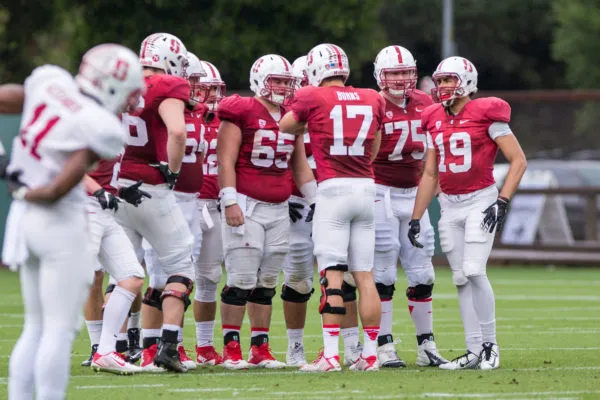
Other than McCaffrey, which player’s performance will be most pivotal to the success of the offense?
VL: Stanford brings back a scary amount of talent at the skill positions. In addition to McCaffrey, the Cardinal boast the blazing Bryce Love in the backfield, talented receivers Michael Rector, Trent Irwin and Francis Owusu and a new crop of tight ends headlined by Dalton Schultz and Greg Taboada. However, the heroic recruiting efforts it took to accumulate all of this talent on The Farm will be for naught if the Cardinal fail to get the ball into the hands of these playmakers in the first place, and that responsibility falls on whoever is named the starting quarterback. At this point, the competition between senior Ryan Burns and junior Keller Chryst probably remains too close to call, but the high level of play both quarterbacks displayed during spring ball and during training camp open practices has many optimistic that whoever is handed the keys will have a lot of success behind the wheel. With the Cardinal facing four of its five highest ranked opponents on the road, the ability of the starting quarterback to handle the pressure and maintain control of the offseason will be critical in determining whether this team sinks or swims, especially in the first half of the season.
DHP: The quarterback is the difference between a good Stanford offense and a great Stanford offense, but the offensive line is the difference between a bad Stanford offense and a good Stanford offense. Bottom line, nothing happens on offense for Stanford unless the offensive line is good — and with that in mind, I’m going to go with center Jesse Burkett. Burkett is the only member of this line without significant in-game experience, and as the center, he’ll need to get used to reading opposing defenses and making important calls for the line while under time and game pressure, the importance of which can’t be understated. Fortunately for the Cardinal, Burkett is a smart guy that shouldn’t be daunted by that task at all, especially after a season’s worth of doing whiteboard work on the sideline (as is Stanford backup center tradition). Reports out of camp are that Burkett has been really impressive physically as well — but his adjustment to full-time play (along with left guard Brandon Fanaika) will dictate how well the new-look Tunnel Workers’ Union gels, especially with the importance of the interior linemen in Stanford’s scheme. And we saw in 2014 just how shaky things can get if the O-line play is rough.
MP: Again, I’m going to follow the lead of one of my colleagues and say that the starting quarterback will be the most important player other than McCaffrey. Though Alabama won the national championship without an elite quarterback, a quick look at the other contenders shows you that great quarterback play is usually a prerequisite to being a playoff team, or even a conference-winning team. Clemson had Deshaun Watson, Oklahoma had Baker Mayfield and Michigan State had Connor Cook — only Alabama and its five-star-recruit-at-every-single-position lineup could pull off the feat without such play. For Stanford to continue to remain as both a conference and national contender, either Burns or Chryst must play at a high level, though it doesn’t need to be as high as Watson or Mayfield. Stanford has the tools on offense to succeed, but it’ll be up to the quarterback to make it happen and help the team deliver in close games.
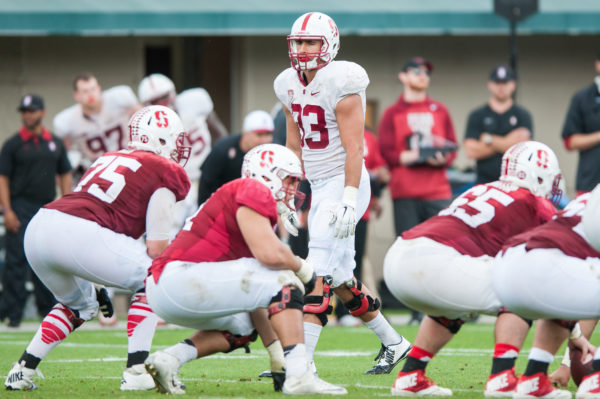
After losing three starters from last season’s offensive line, what can the Cardinal expect of a largely new Tunnel Workers Union and how crucial will the line’s performance be to the success of the new quarterback and McCaffrey?
VL: It’s hard to gauge just what to expect out of such a retooled offensive line. The last time Stanford underwent such a massive facelift up front, in 2014, we learned that the whole isn’t always equal to the sum of its parts — at least not right away — as Andrus Peat, Josh Garnett, Graham Shuler, Johnny Caspers and Kyle Murphy struggled to gel immediately. However, flash forward one season later and that very same line — minus Peat — became one of the best units in the country.
Along similar lines, I could see the 2016 edition of the Tunnel Workers Union experiencing some growing pains early on, especially with the big, bad USC Trojans defensive line coming to town for the second game of the season. The deafening atmospheres in Husky Stadium and Autzen Stadium probably won’t do this young line any favors either as the 2014 group struggled mightily with penalties, especially early on. Ultimately, though, there are plenty of reasons to be optimistic. Offensive coordinator Mike Bloomgren has proven to be one of the best offensive line developers in the game and the initial reviews on Jesse Burkett and Dave Bright have been very positive while Johnny Caspers and Casey Tucker bring valuable starting experience. The fifth spot remains largely up for grabs, but both Brandon Fanaika and AT Hall saw the field in 2015 on either jumbo packages or special teams. It might not be very pretty at the outset, but I expect this unit to be where they want by the home stretch of the season.
DHP: Honestly, I have no idea what to expect from the offensive line. Not having been in on the discussions behind closed doors in 2014 and not knowing the details of offensive line technique, I’m not the best person to evaluate what exactly went wrong with the 2014 line, so I’m not going to try. These new linemen are very different from the new linemen Stanford was breaking in back then, and so I’m not sure if we can draw too many corollaries between the two situations. That said, 2014 did show us just how badly things can go wrong for Stanford if the offensive line is shaky. I honestly think it’s impossible to tell how things will turn out until they actually happen — so we’ll just have to deal with the uncertainty and wait. Usually, I’d say that the running back’s success correlates directly with the offensive line’s success, but in this case, I think McCaffrey is the ultimate safety valve in that his improvisational skills and his maneuverability are unparalleled — even when plays break down or the run blocking isn’t stellar, he’ll make the most of any play.
MP: Like Vihan said, this unit has a lot of similarity to the 2014 offensive line, which broke in four new starters, albeit very talented ones. This time around the Cardinal have a little more experience if maybe a little less talent than 2014. However, as Vihan alluded to, the 2014 unit struggled early on, contributing to the Cardinal’s 8-5 campaign. There is zero margin for error early on in the 2016 season with USC, UCLA, Washington and Notre Dame waiting, to say nothing of upset-minded Washington State and Bill Snyder-led Kansas State. A similar poor early-season performance could spell another 8-5 campaign. While I’m optimistic like Vihan, I’m also more tentative and cautious. The Tunnel Workers Union has always been a key to Stanford’s success and it has to be again in 2016 if Stanford is to contend. The return of fifth-year senior and team captain Johnny Caspers is a huge plus to the unit and a big reason why I ultimately believe the offensive line will do just fine. If there’s one position group that has to do well though, it’s the offensive line.
Contact Vihan Lakshman at vihan ‘at’ stanford.edu, Do-Hyoung Park at dhpark ‘at’ stanford.edu and Michael Peterson at mrpeters ‘at’ stanford.edu.
